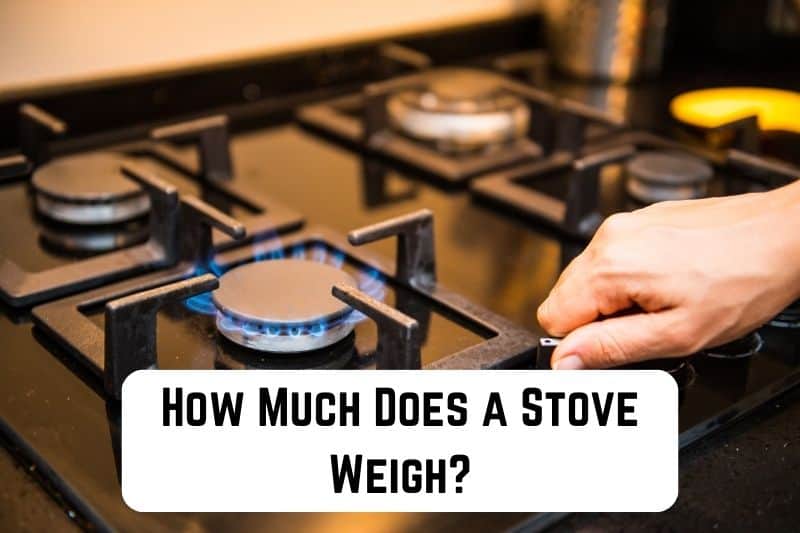When buying or replacing a stove, one important factor to consider is its weight. As a crucial kitchen appliance, it’s essential to know the heft of a stove to ensure proper installation and usage.
The weight of a stove is not only important for the ease of installation but also for making adjustments in the kitchen layout or moving homes.
Several factors contribute to a stove’s weight, such as its size, material, and features. For instance, a small electric stove may weigh around 100 pounds, while a larger gas range with multiple burners and ovens can exceed 350 pounds. So, understanding the weight of different stove models is necessary for making an informed decision.
To help you determine the weight of various stoves, I’ll discuss the factors contributing to their heft and provide some examples of different stoves and their average weights. This way, you’ll have a better idea of what to expect when choosing a new stove for your kitchen.
Read: How Much Does a Wrecking Ball Weigh? (Up to 12,000 pounds)
Freestanding stoves weigh between 150 to 200 pounds. The average weight for a slide-in stove is between 120 to 180 pounds. Drop-in stoves weigh between 100 to 160 pounds on average.
Understanding Stove Types
As a cooking enthusiast, I am always exploring different types of stoves for my kitchen. Here, I’ll discuss the three major stove types: gas, electric, and wood-burning.
Gas Stoves
To me, gas stoves are the most traditional type of stove. They typically have four burners on top and an oven beneath. These stoves use natural gas or propane as fuel, delivering instant, adjustable heat to the cookware. Some advantages of gas stoves include:
- Precise temperature control: I can turn the heat up or down immediately, which helps me cook my food perfectly.
- Even heat distribution: This makes it easier to cook delicate dishes like sauces and custards.
- Economical: Natural gas can be less expensive than electricity in many areas.
Electric Stoves
Electric stoves, on the other hand, use electricity to generate heat, which is then transferred to the cooking vessel. There are two main types of electric stoves: coil and smooth top models. Some benefits of electric stoves include:
- Even and consistent heat: My food gets cooked evenly, helping me achieve consistent results.
- Easy to clean: Smooth top models have a glass or ceramic surface, making it simple to wipe away spills.
- Safety: Electric stoves tend to cool down faster than gas stoves after being turned off.
Wood Burning Stoves
Lastly, wood-burning stoves are a more traditional option, often found in rustic settings or off-grid homes. These stoves require wood as fuel and provide direct heat for cooking. A few of the compelling aspects of wood-burning stoves are:
- Renewable energy source: Using wood from sustainably managed forests can make this an eco-friendly appliance.
- Heating: Some models can also double as a heating source for my home during colder months.
- Aesthetic appeal: These stoves can add a charming, rustic look to my space.

Average Weight of Different Stove Models
I will discuss the average weight of three popular stove models: freestanding stoves, slide-in stoves, and drop-in stoves.
Freestanding Stoves
Freestanding stoves are the most common type of stove, and their weight varies depending on the size and material. On average, they weigh between 150 to 200 pounds.
Most freestanding stoves are made from either stainless steel or aluminum, with stainless steel being heavier. A few design features that can influence the weight are:
- Size: Often, larger stoves weigh more due to additional materials.
- Burner count: Stoves with more burners typically weigh more.
- Oven capacity: Larger ovens can add extra weight to the stove.
Slide-In Stoves
Slide-in stoves are designed to fit between cabinets, making them slightly more streamlined and lighter than freestanding stoves. The average weight for a slide-in stove is between 120 to 180 pounds. Like freestanding stoves, the weight depends on size, material, and design features. Some key factors are:
- Size: Smaller slide-in stoves will generally weigh less.
- Material: Aluminum stoves will weigh less than their stainless steel counterparts.
- Features: Additional features, like convection ovens or extra burners, can affect weight.
Drop-In Stoves
Drop-in stoves are custom-built to fit into a specific cabinet opening and rest on a built-in ledge. They weigh between 100 to 160 pounds on average, making them the lightest of the three types. The factors that influence the weight of drop-in stoves are similar to the other two models, such as:
- Size: Like the other stove models, size plays a role in the weight.
- Material: Heavier materials, like stainless steel, contribute to added weight.
- Features: More advanced features can contribute to a slightly heavier stove.
Understanding the average weight of different stove models makes it easier for you to plan and prepare for the installation and transportation of your new stove.
Factors Impacting Stove Weight
In this section, I will discuss the factors that can impact a stove’s weight. There are two primary factors to consider: the material used and the size and dimensions of the stove.
Material Used
The material used in a stove’s construction is one of the main determinants of its weight. Stoves can be made from a variety of materials, such as:
- Cast iron: This is a heavy and durable material commonly used in traditional stoves. A cast iron stove can weigh anywhere between 200 to 500 pounds, depending on its size.
- Stainless steel: This is a popular choice for modern stoves and ranges. Stainless steel stoves are relatively lighter and typically weigh between 100 to 300 pounds.
- Aluminum: Some lightweight portable camping stoves are made from aluminum, lighter than cast iron and stainless steel. These stoves usually weigh only a few pounds.
Size and Dimensions
Another factor that influences a stove’s weight is its size and dimensions. Larger stoves tend to weigh more than smaller ones.
Read: How Much Does a Can of Coke Weigh? (Answered)
Here are some common stove sizes and their approximate weight ranges:
- Standard: Standard stoves, also known as full-sized stoves, measure about 30 inches wide. They usually weigh between 100 to 250 pounds, depending on the material used.
- Compact: Compact stoves are smaller, typically around 20 to 24 inches wide. These stoves can weigh anywhere from 75 to 150 pounds.
- Portable: Portable stoves, like camping stoves, are designed to be lightweight and easy to carry. They can weigh as little as 2 to 10 pounds.
Frequently Asked Questions
What is the weight of a gas stove?
In my experience, the weight of a gas stove varies based on its size and the materials used in its construction. On average, a standard 20-inch gas stove may weigh around 100-120 pounds, while a larger 30-inch model can weigh anywhere from 150-200 pounds.
What is the weight of an electric oven?
Electric ovens generally share similar weights as their gas counterparts. A smaller 20-inch electric oven may weigh around 100-120 pounds, while a larger 30-inch version can range from 150-200 pounds. The weight can fluctuate depending on the materials used and the oven’s additional features.
How heavy is a standard 30-inch stove?
As I mentioned earlier, a standard 30-inch stove, whether it is gas or electric, usually weighs between 150-200 pounds. Factors like additional features, such as convection options or glass cooktops, can affect the overall weight, so it’s essential to check the specific manufacturer’s specifications.
Do stove sizes affect their weight?
Yes, stove sizes do have an impact on their weight. Typically, larger stoves weigh more than smaller ones due to their increased size. This includes the overall dimensions, materials used, and additional features. For instance, a 36-inch stove will usually weigh more than a 30-inch stove.
What’s the weight difference between a 36-inch gas stove and a 30-inch stove?
A 30-inch gas stove commonly weighs between 150-200 pounds. Meanwhile, a 36-inch gas stove weighs 200-250 pounds. Remember that these numbers are approximations, and the exact weight of any particular stove will depend on its materials, brand, and additional features.







